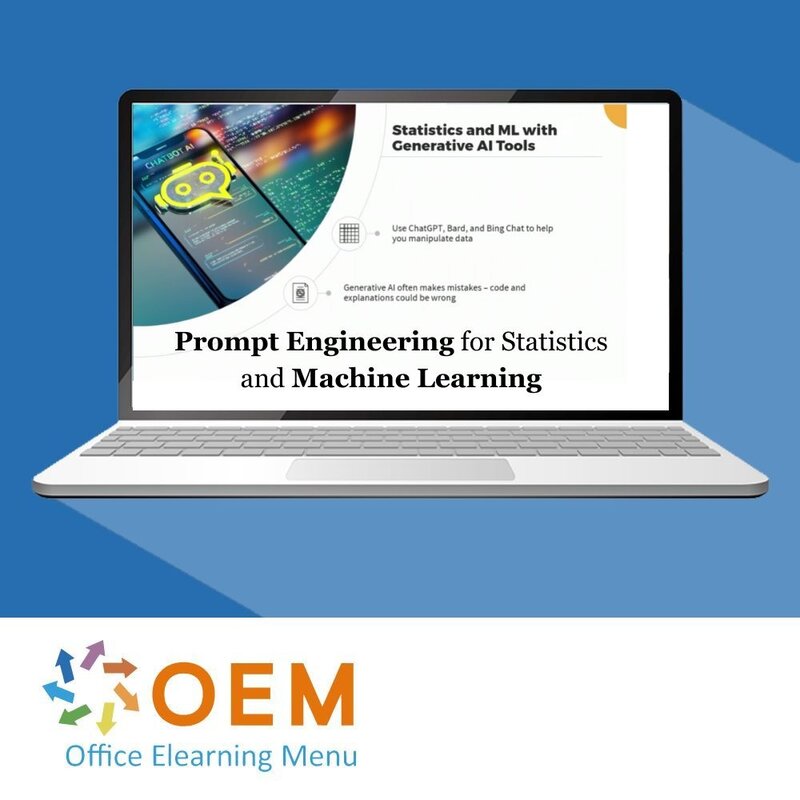Prompt Engineering for Statistics and Machine Learning Training





Prompt Engineering for Statistics and Machine Learning Training
Prompt Engineering for Statistics and Machine Learning E-Learning Training Certified teachers Quizzes Assessments Tips tricks and Certificate.
Read more- Discounts:
-
- Buy 2 for €194,04 each and save 2%
- Buy 3 for €192,06 each and save 3%
- Buy 4 for €190,08 each and save 4%
- Buy 5 for €188,10 each and save 5%
- Buy 10 for €178,20 each and save 10%
- Buy 25 for €168,30 each and save 15%
- Buy 50 for €158,40 each and save 20%
- Availability:
- In stock
- Delivery time:
- Ordered before 5 p.m.! Start today.
- Award Winning E-learning
- Lowest price guarantee
- Personalized service by our expert team
- Pay safely online or by invoice
- Order and start within 24 hours
Prompt Engineering for Statistics and Machine Learning E-Learning
Accelerate your learning in statistics and machine learning using natural language prompts with ChatGPT and Bard.
This comprehensive learning journey teaches you how to write effective prompts for performing statistical analyses and machine learning tasks. From basic descriptive statistics to hypothesis testing using T-tests and ANOVA, you’ll use AI platforms to guide your analysis and validate your results.
You’ll transition into machine learning prompts, covering data exploration, visualization, and preprocessing techniques like standardization and encoding. Then, dive into regression models, decision trees, logistic regression, and clustering methods like k-means—all guided by powerful AI tools that support you at every step.
Why Choose This Training?
- Learn through prompt-based AI interactions with ChatGPT and Bard
- Master descriptive stats, T-tests, ANOVA, and key ML models
- Apply AI-generated prompts to streamline data analysis and modeling
- Gain hands-on experience with real-world machine learning workflows
- 365-day access to e-learning, practice labs, final exams, and mentor guidance
Who Should Enroll?
This course is ideal for:
- Students and aspiring data scientists
- Analysts or developers starting with ML/statistics
- Business professionals leveraging AI for decision-making
- Educators modernizing their approach to teaching stats/ML
This Learning Kit with more than 5 hours of learning is divided into three tracks:
Course content
Computing Descriptive Statistics Using Prompt Engineering
- Statistics is a branch of mathematics that involves the collection, analysis, interpretation, presentation, and organization of data. It provides a framework for making inferences and drawing generalizable conclusions from observed information and it offers great tools to uncover patterns, trends, and relationships within datasets. Begin this course by exploring two important types of statistics – descriptive and inferential statistics. Next, learn how to compute and interpret descriptive statistics in code, including measures of central tendency and dispersion, mean and median, and range. Then use generative artificial intelligence (AI) tools to help interpret visualizations and understand the nuance between the different statistical measures and when you would choose to use them. After completing this course, you will have a solid understanding of how to calculate, interpret, and visualize descriptive statistics using Python and be able to leverage prompt engineering to help implementation and interpretation.
Running Statistical Tests Using Generative AI Tools
- Hypothesis testing is an important part of inferential statistics that involves assessing sample data to draw conclusions about a population parameter. Begin this course by exploring how hypothesis tests work, the results they generate, and how you interpret those results. You will learn how you set up the null and alternative hypotheses for tests and how to interpret the results which includes the test statistic and the p-value. Then you will discover the different types of t-tests, such as one-sample, two-sample, and paired samples. Finally, you will investigate the use of generative artificial intelligence (AI) tools to implement one-sample t-tests and interpret the results. At course completion, you will have a solid understanding of the basics of hypothesis testing and how prompt engineering can help you implement and interpret these statistical tests.
Prompt Engineering for Hypothesis Testing
- T-tests and analysis of variance (ANOVA) are statistical methods used to compare means between groups and assess whether observed differences are statistically significant. In this course, you will perform two-sample t-tests, comparing two independent groups to determine if the difference between their means is statistically significant. You will use ChatGPT and Google Bard to help ensure that your samples meet the assumptions of the t-test. Then you will visualize and interpret the characteristics of your data and run the right variation of the t-test based on your data. Next, you will run a paired sample t-test with help from generative artificial intelligence (AI) tools. Finally, you will use ANOVA to compare multiple samples simultaneously, use prompt engineering to determine when to use ANOVA, and use post-hoc analysis after running ANOVA to identify which groups or categories are significantly different. After completing this course, you will have a solid understanding of t-tests and ANOVA and be able to leverage Generative AI tools to help you with your analysis.
Prompt Engineering for Machine Learning
- Machine learning involves creating models that dynamically change based on the data from which they are created. Within machine learning, three fundamental problems—regression, classification, and clustering—are the focus of a variety of solution techniques. Begin this course by conducting regression analysis. You will analyze and visualize data to get a sense of the variables with predictive power, split data into training and test sets, and train a model. Then you will interpret the R-squared metric to evaluate how well the regression model has performed. Next, you will create a classification model for predicting categorical targets and split your data into test and training data to train a logistic regression model. You will also explore the impact of training a model on imbalanced data, and with generative artificial intelligence (AI) assistance, see how you can mitigate this by leveraging oversampling and undersampling techniques. Finally, you will perform clustering, train a k-means clustering model, and evaluate it using the silhouette and Davies-Bouldin scores. At course completion, you will have a good understanding of key concepts of machine learning and how to perform regression analysis, classification of data, and clustering.
Assessment:
- Final Exam: Prompt Engineering Use Cases
| Language | English |
|---|---|
| Qualifications of the Instructor | Certified |
| Course Format and Length | Teaching videos with subtitles, interactive elements and assignments and tests |
| Lesson duration | 5:34 Hours |
| Assesments | The assessment tests your knowledge and application skills of the topics in the learning pathway. It is available 365 days after activation. |
| Online Virtuele labs | Receive 12 months of access to virtual labs corresponding to traditional course configuration. Active for 365 days after activation, availability varies by Training |
| Online mentor | You will have 24/7 access to an online mentor for all your specific technical questions on the study topic. The online mentor is available 365 days after activation, depending on the chosen Learning Kit. |
| Progress monitoring | Yes |
| Access to Material | 365 days |
| Technical Requirements | Computer or mobile device, Stable internet connections Web browsersuch as Chrome, Firefox, Safari or Edge. |
| Support or Assistance | Helpdesk and online knowledge base 24/7 |
| Certification | Certificate of participation in PDF format |
| Price and costs | Course price at no extra cost |
| Cancellation policy and money-back guarantee | We assess this on a case-by-case basis |
| Award Winning E-learning | Yes |
| Tip! | Provide a quiet learning environment, time and motivation, audio equipment such as headphones or speakers for audio, account information such as login details to access the e-learning platform. |
There are no reviews written yet about this product.
OEM Office Elearning Menu Top 2 in ICT-trainingen 2024!
OEM Office Elearning Menu is trots op de tweede plaats in de categorie ICT-trainingen 2024 bij Beste Opleider van Nederland (Springest/Archipel). Dank aan al onze cursisten voor hun vertrouwen!
Reviews
There are no reviews written yet about this product.

























